MAKE SOIL HEALTH YOUR NUMBER ONE PRIORITY

The importance of good soil health cannot be overstated, but the key is to achieve it. Strip seeding pioneer Jeff Claydon, who farms in Suffolk and designed the Claydon Opti-Till® System, explains how
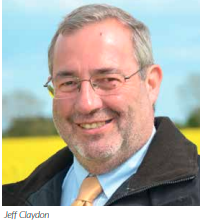
In my last article for Direct Driller I mentioned briefly the importance of good soil health in producing highyielding, profitable crops and here I want to consider the subject in greater detail as it is critical to maximise the benefits of strip seeding. Soil health is a fascinating subject, as many of the 100-plus farmers who attended the Claydon open days at our factory and farm in Suffolk in May found out from leading experts. More from them later. Healthy, well-structured soils with excellent worm populations eliminate many of the risks involved in producing crops. Therefore, soil health must be the Number One priority for UK farming businesses if they are to survive and thrive in an increasingly uncertain global market environment.
The subject is particularly relevant now as many farmers who operate a conventional crop establishment system based on ploughing or deep tillage will be making a loss on every tonne of combinable crops produced at current prices because their costs are too high. These methods can also have an adverse impact on soil health, so to improve it whilst containing costs will require them to change radically how they establish crops. Conventional full cultivations and min-till systems can over-work the soil and destroy its structure, which adversely impacts worm populations and activity. The use of min-till systems and disc-type direct drills can also result in soils which drain poorly and flood easily, creating crops with poor rooting structures and low yield potential.
Degrading the soil in this way also reduces its ability to drain water away during periods of wet weather and increases moisture losses in dry conditions. If, after heavy rainfall, you see dirty water flowing from field drains that means it is full of sediment, so your valuable soils have been degraded by over-cultivation and are literally being flushed down the drain. This sediment will block worm holes and capillaries, starving the crop’s roots of essential air and nutrients, reducing yield potential and ultimately increasing the cost-pertonne of production, as well as creating greater risks from flooding and further soil erosion. With greater public awareness of the countryside and environmental issues such as soil erosion caused by poor agricultural practices farming businesses should review how they operate. A key part of that process is to reduce the agronomic and financial risks involved in producing crops, many of which result from traditional approaches to establishment. But that’s not to say you should go from one extreme to the other.
It is understandable that in the current economic environment farmers want to save costs, but you should not go into no- or reduced-tillage systems without fully understanding the concept and how to apply it successfully. There is no point in saving money on establishment if you don’t get a crop! In my view a completely notill approach cannot produce the consistent, reliable results and high yields which we have achieved with the Opti-Till System of strip seeding during the last 16 years, particularly on heavier soils. Using no-till alone also poses significant risk as you are much more at the mercy of wet seasons or dry seasons and may struggle to get seed in the ground or achieve sustainable yields, while corrective subsoiling may be required if the soil slumps. However, in some seasons a mix could work well, if you are able to justify the use of two drills.
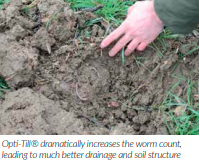
A Holistic Approach
Claydon pioneered strip seeding and has perfected the Opti-Till® System, a holistic approach to crop establishment which delivers consistently high yields at low cost, thereby maximising profitability. Providing that the soil is drained, is reasonably sound, work is done when conditions are suitable, and you have a good rotation to help control weeds then this technique is suitable for every farm.
There are huge benefits from using Opti-Till® correctly. Soil health and structure are greatly improved, soil drains more freely in wet weather and retains moisture in dry conditions, while earthworm numbers are dramatically higher. This is critical, because healthy, well-structured soils with excellent worm populations eliminate many of the risks involved in producing crops. Rooting structures are much stronger, resulting in better crops that utilise inputs more effectively and more efficiently whilst being more resistant to drought, while yields increase and ‘per-tonne’ production costs are much lower.
The start of the process is to use the Claydon Straw Harrow to produce a shallow micro tilth up to 30mm deep, which destroys slugs and slug eggs and encourages volunteers and weeds to chit, enabling them to be controlled more effectively, at lower cost and with less reliance on chemicals. This micro tilth is usually more than adequate to cover the seed, create a warm, humid environment around it and promote rapid crop establishment. If slightly more tilth is required it can be created with a Claydon TerraStar light rotary cultivator.
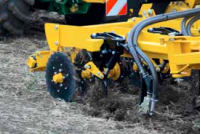
The key to Opti-Till® is the Hybrid drill’s patented, leading tine, which has a breakout force of 600kg, more than twice that of many other direct drills, so it remains stable and works at an even depth. Adjustable from 0mm to up to 150mm deep for establishing deeprooting crops like oilseed rape, it lifts and aerates the soil, creating fissures, alleviating localised compaction, improving drainage and providing space for strong rooting structures to develop. The leading tine is followed by a separate seeding tine which places seed within a band in soil which has just been lifted and loosened. Using press wheels on the drill or rolling separately immediately after drilling, particularly on heavy soils which are wet, pushes the air out of the soil and can cause the particles to stick together. Therefore, we recommend letting the soil ‘haze over’ for 24-48 hours after drilling and then rolling or harrowing. This approach delivers perfect results.

The Opti-Till System does just enough to make direct drilling work without the need to subsoil, as with a lowdisturbance drill system, or having to correct damage from the sedimentation of over-worked soils where min-till or plough-based establishment is used. Doing just enough cultivation at the point of drilling retains the soil structure, provides the crop with the ideal growing environment and gives it the strongest possible start. This allows the soil to start improving and the sooner this process begins the more quickly it will do so. Targeting cultivations in this way ensures that soil density is retained over at least 50% of the field, which supports following field traffic throughout the season and keeps tramline depths to a minimum. Fields are left level due to the design of the Claydon Hybrid drill, soil structure and seedbeds are consistent over large areas, so crops develop and grow evenly. That makes it much easier to apply fertilisers and agrochemicals at the optimum time.

Drilling seed in bands provides an ideal environment for worms to thrive. This is essential because their action benefits soil health in so many ways. Because most worm burrows and capillaries are left undisturbed worm numbers are safeguarded, which aids drainage and water movement through the soil profile throughout the growing season. Plant roots are also left largely undisturbed which adds to the soil biota and improves soil structure, organic matter depletion is minimised due to nominal soil disturbance, while soil moisture and nitrogen are preserved.
The friable tilth created by the Claydon leading tine allows fast, strong rooting. Emergence is rapid and unhindered due to the excellent soil structure, while the soil can also absorb heavy rainfall without capping. Because the seed is sown in bands crops utilise more of the growing area, maximising moisture and nutrient takeup. The fact that seed is spread across the working area of the seeding share allows more air and light into the crop, which improves photosynthesis as the plant grows.
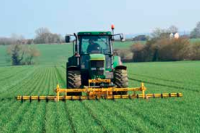
A further benefit of strip seeding is that drilling into stubbles helps to keep snow in place and settled on the seeded area, which acts like an insulating blanket for the crop in very cold weather. As the temperature rises, snow thaws and melt water drains through the soil profile. This area also warms more quickly due to the darker colour of the soil. The other advantage of strip seeding at 30cm centres is that the 14-15cmwide unseeded strip between the rows can be mechanically hoed. The Claydon TerraBlade inter-row hoe is a low-cost, mechanical method of controlling weeds in combinable, bandsown crops.
It provides an additional weapon in the agricultural industry’s weed control armoury at a time when the efficacy of some herbicides is decreasing whilst the cost of control is increasing. The TerraBlade eliminates weeds from that area reliably, safely and without using chemicals. This clears up any weeds that were missed by the ag-chems, or where such products cannot be used, greatly reducing the return of weed seeds, the overall weed burden, the potential for carry-over of weeds seeds and the risk of more resistant types developing. By keeping the unseeded rows clear of weeds during the early stages of crop growth, competition for nutrients, light, air and water is reduced and the young plants grow away strong and healthy.
When soil is biologically healthy and you have created a high worm population with a high level of worm activity, many soil-related issues, as well as many of the risks involved in producing crops, diminish greatly. In the 16 years of using the Opti-Till® System on the Claydon farms we have seen much lower levels of plant disease than on farms which still plough due to the much higher levels of soil biological activity. Instead of continuing the cycle of poor soil structure caused by conventional methods of crop establishment it makes sense to re-evaluate what is required going forward. Innovative equipment such as the Claydon Opti-Till® System greatly improves timeliness, reduces establishment costs by up to 80%, creates correctly structured, supportive soils, encourages high worm populations, promotes biodiversity and ensures excellent drainage. This results in sustainable, high yields, greater resilience to extreme weather, numerous environmental benefits and improved profitability.
But you should not expect simply to buy this type of equipment and expect instant results. It is important to understand how to get the best from this new approach, correct any deficiencies in soil nutrition and introduce an effective programme of stubble management between harvest and drilling. We invited Dick Neale, Technical Manager of Hutchinsons Crop Protection, to the Claydon open days to explain more about the importance of soils and how to achieve good structure. Visitors found what he had to say fascinating.
Transitioning To Strip Seeding
“Transitioning from conventional crop establishment methods to strip seeding is not difficult, but there is a process to go through to achieve optimum results,” Dick stated. “It’s very easy to get right, but also very, very easy to get wrong, so understand what needs to be done, appreciate that it takes time, be patient and do not expect instant results. “Many fields are over-cultivated and consequently farmers often say that their soil does not work like it used to, do what it used to or produce crops like it used to. Much of this is down to the fact that in a plough-based system there are 80 per cent less earthworms, so it will take two to three years to build their numbers sufficiently to completely break down surface residues and for the soil and ecology to adapt to a strip seeding system. When changing to the Claydon System you should therefore ensure that your stubble is very well managed or grow a catch/cover crop.”
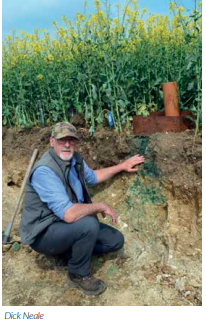
Emphasising the critical importance of having a healthy earthworm population, Dick stressed the need to know the main types and how they operate:
• Epigeic: Spend most of their life above ground and survive by processing decaying/dead organic matter.
• Anecic: Tend to make vertical tunnels and their primary food source is decaying matter on the soil surface, such as stubbles. Can often be identified by characteristic soil ‘middens’ surrounding the tunnel entrance.
• Endogeic: Create sprawling burrows underground, only come to the surface when excess rain puts them at risk of drowning and live on organic matter beneath and mixed into the soil. They are key to optimising the soil’s structure, drainage capability and ability to store water and nutrients, but are very sensitive to cultivations.
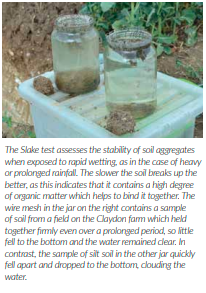
“Worms burrow up to 2m deep, way beyond the scope of any mole drainer or subsoiler tine and are fundamental to efficiently draining and oxygenating the soil,” he added. “As they move throughout the profile they act as pumps, pushing oxygen around the network of borrows, but to do so must have access to surface straw to provide food. If we can achieve 30 deep-working earthworms per square metre things really start to happen in terms of benefits to the soil.”
Give Your Soils A Helping Hand
Another guest speaker at the Claydon open days, Dr Elizabeth Stockdale, Head of Farming Systems Research at NIAB, said that every farmer should ask themselves ‘How can I help the soil life help me?’ Soil is a very complex web of interactions, but if it is in the right condition, with the right structure and nutrition in place it will deliver the results you are looking for. The key is to appreciate that its natural biology is there waiting to help; you just need to create the conditions to allow it to kick in. She added:
“The physical, biological and chemical properties of the soil must all be right for it to deliver optimum performance. Address the soil’s physical component by knowing your textures, understand its limits in terms of workability and trafficability, optimise water balance through drainage if necessary, improve soil structure and minimise compaction to achieve effective, continuous pore space. Optimise the soil’s biology by feeding it regularly through plants and organic matter inputs, moving it only when necessary and diversifying plants in space and time. To address the chemical side, maintain optimum pH, provide the right amount of plant nutrients, in the right place, at the right time, and know your soil textures, as their buffering capacity provides a free supply of minerals.

“All land is unique and often one field can contain several different types of soil, which set the inherent limits to its physical properties, while management modifies those properties. Soil structure is broken, not made, by machinery: the plant roots, earthworms and glues/ gums created by the decomposition process are the keys to the soil’s structure and aggregating ability. Food diversity is essential for both human and soil health, so adding more food to the land will allow it to support more biodiversity. Therefore, move soil only when necessary, avoid leaving ground bare and ensure that crops are grown in optimum conditions so they can maximise photosynthesis. “Working effectively with the soil requires an integrated, flexible approach to soil husbandry. Changing one aspect of a system can change the entire outcome and so, for example, the same drill might work differently in different situations and soils. When changing to strip seeding you cannot simply buy a new drill and expect that everything will be fine: you must adapt your system and tailor your husbandry accordingly.”
FINAL THOUGHTS
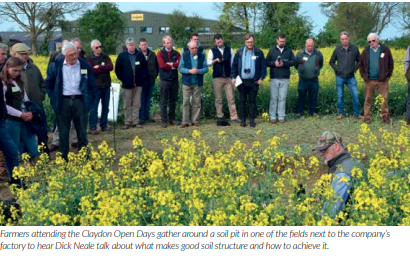
The cost of the Claydon Opti-Till System is much lower even than with min-till and dramatically less than a plough-based system. Instead of using 150-180 litres of fuel/ha to establish a crop using a ploughbased system, with Opti-Till we use 10-15 litres/ha (average 12l/ha), which includes stubble management and drilling. The enormous savings that we make allow us to invest more in other inputs and areas of the farm that really make a difference. The cost of wearing metal is very low, at just £3-£4/ha. As the soil becomes healthier and in better condition the amount of power required to work it and cost of wearing metal continues to decline. Power requirement is just 50hp per metre for Claydon Hybrid drills, so output is much higher and fuel use is dramatically lower.
On the Claydon farms we use a 300hp tractor to pull our 6m Claydon Hybrid drill and because of the very high work-rate the tractor clocks up less than 100 hours per year to establish our 350ha of crops. With everything in the ground in good time we have time to do another 1250ha of contract drilling, creating additional revenue. It is not our experience to see a yield decrease where soil is in reasonable condition when you start with the Claydon System. We have seen an average 10% increase in yields on Claydon-drilled farms, as have customers who start with soils which are in reasonable condition, free of compaction, drainage or weed issues.

To learn more about the ClaydonOpti-Till® System
scan the code.
